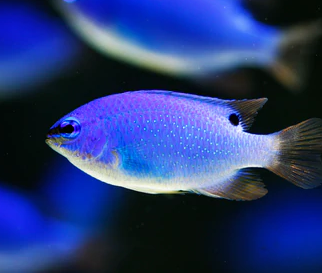| Blue Devil Damselfish |
| CARE LEVEL | TEMPERAMENT | DIET |
REEF SAFE |
| Easy | Semi-Aggressive |
Omnivore |
Yes |
| PURCHASE SIZE | MAX SIZE |
ORIGIN |
TANK SIZE |
| APPROX 1.5" | 2.75" |
Indo, Solomon | 30g |
| SG |
TEMPERATURE |
dKH |
pH |
| 1.020-1.025 | 72-78F |
8-12 |
8.1-8.4 |
|
View Marine Fish Compatibility Chart Chrysiptera cyaneaChrysiptera cyanea, from the Greek words "chrysos" meaning golden and "pteron" meaning fin/wing, is a species of damselfish that goes by many names, such as blue damselfish, blue demoiselle, sky-blue damsel, orange-tail blue damselfish (usually referring to the males), Hedley's damselfish, sapphire devil, and blue devil damselfish. The photos that you can find online of these fish never seem to do their deep, blue coloring justice. The gorgeous, vibrant blue scales of the blue devil damselfish really catch the light beautifully in person. Females and juvenile males of this species will usually have a black dot on their dorsal fin. The females tend to stay almost completely blue, while the males develop that vibrant yellowish-orange coloring on their snouts that may extend to their chest, fins, and tails. The blue devil damselfish has the ability to darken to an almost black color quickly. This usually happens when it is threatened and trying to hide. After the perceived threat is gone, it will return to its normal color in a matter of moments. Growing up to 3 inches in length, these hardy fish are good for new and veteran reef chasers in a tank over 30 gallons. They are also a great choice for reef aquariums with invertebrates. Blue devil damselfish are also relatively easy to please with a variety foods. In the wild, they eat a variety of zooplankton, worms, brine shrimp, and copepods. They readily accept most frozen foods. Some blue devil damselfish will accept flake foods, but some may reject it. Damselfish, along with other fish, corals and invertebrates will also benefit greatly from Live Phytoplankton which is readily available to them in the wild. |
|
For more information about this species and more visit our Marine Fish Care Blog.
|

